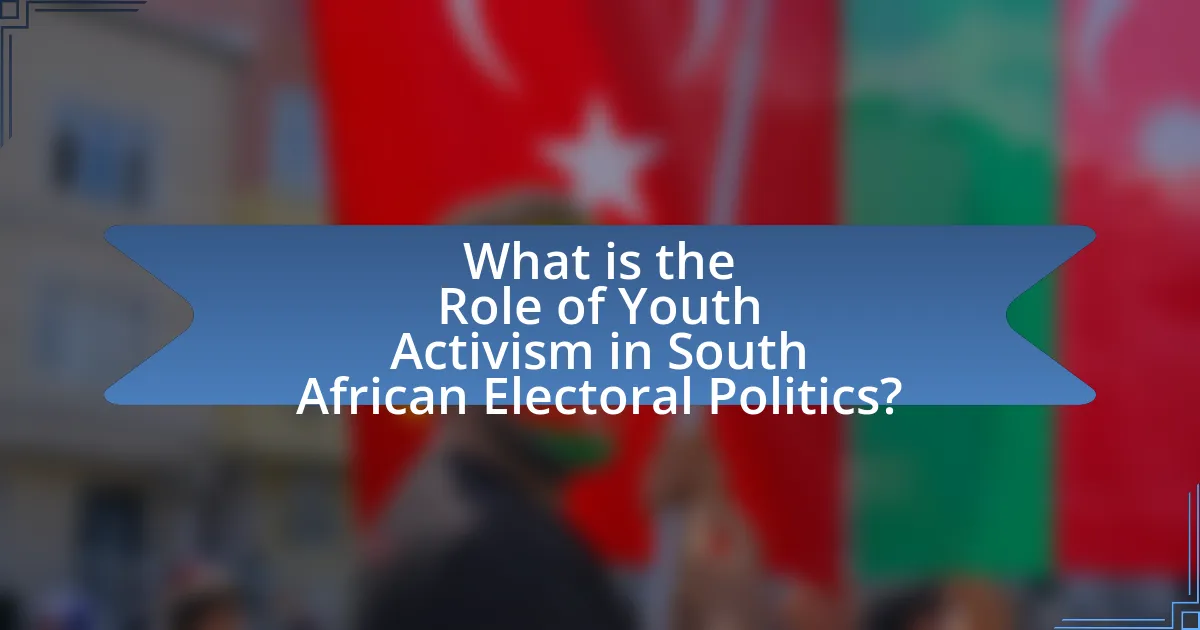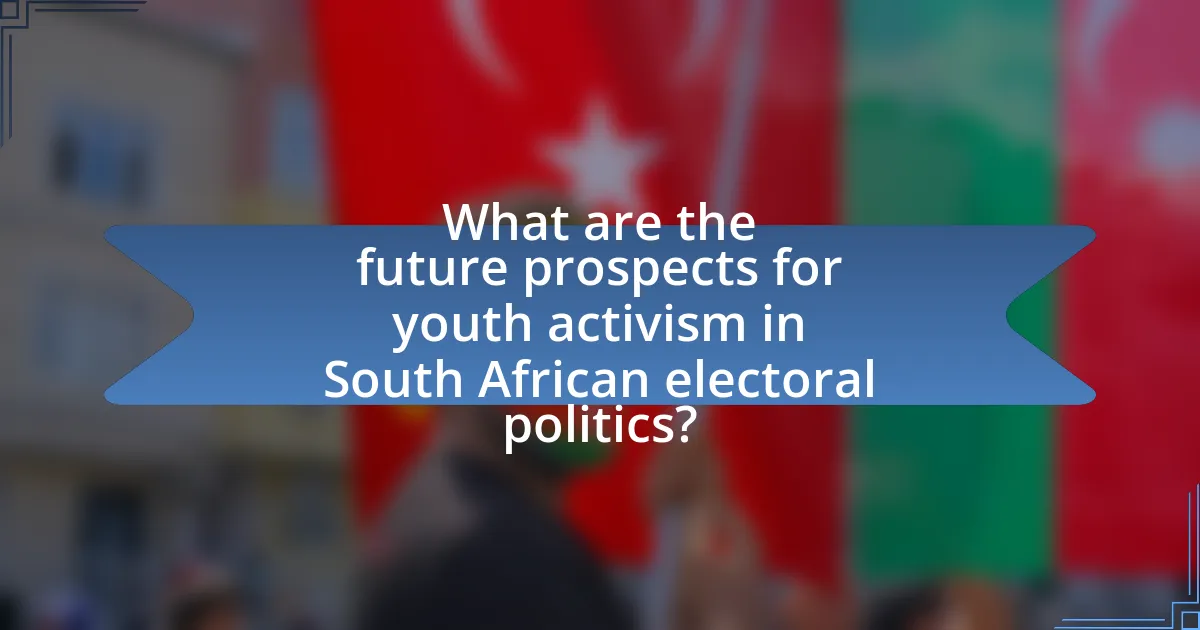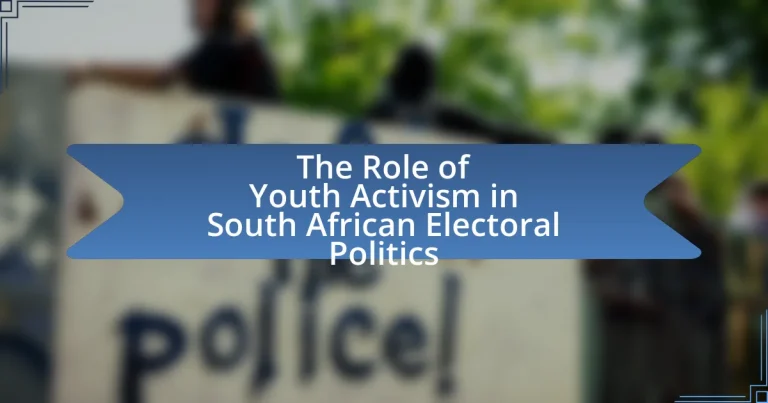Youth activism is a significant force in South African electoral politics, mobilizing young voters and shaping policy agendas. This demographic, which represents a substantial portion of the electorate, has historically influenced political discourse through movements such as #FeesMustFall and #ZumaMustFall, addressing critical issues like education funding and corruption. The article explores the historical context of youth activism, key events that have marked its rise, and the unique perspectives young activists bring to political discourse. It also examines the challenges faced by youth activists, the impact of socio-economic factors, and the role of government policy in shaping their engagement. Additionally, the article highlights the effectiveness of social media in mobilizing youth and discusses future prospects for activism in South Africa’s electoral landscape.

What is the Role of Youth Activism in South African Electoral Politics?
Youth activism plays a crucial role in South African electoral politics by mobilizing young voters and influencing policy agendas. This demographic, which constitutes a significant portion of the electorate, has been pivotal in shaping political discourse, particularly through movements like #FeesMustFall and #ZumaMustFall, which highlighted issues such as education funding and corruption. According to the Electoral Commission of South Africa, youth participation in elections has increased, reflecting their growing engagement and the impact of social media in organizing and raising awareness. This activism not only drives voter turnout but also pressures political parties to address youth-specific concerns, thereby transforming the political landscape.
How has youth activism historically influenced electoral politics in South Africa?
Youth activism has historically influenced electoral politics in South Africa by mobilizing young people to challenge oppressive systems and advocate for democratic reforms. Notably, the Soweto Uprising in 1976, where students protested against the imposition of Afrikaans in schools, galvanized national and international attention, leading to increased pressure on the apartheid regime. This activism contributed to the eventual dismantling of apartheid and the establishment of a democratic electoral system in 1994, where youth participation was crucial in shaping policies and political discourse. The formation of organizations like the South African Students’ Organization (SASO) and the Congress of South African Students (COSAS) further exemplified how youth movements could directly impact political agendas and electoral outcomes, emphasizing the importance of youth voices in shaping the nation’s future.
What key events have marked the rise of youth activism in South Africa?
Key events that have marked the rise of youth activism in South Africa include the 1976 Soweto Uprising, the formation of the South African Students’ Organization in the 1960s, and the #FeesMustFall movement in 2015. The Soweto Uprising, where students protested against Afrikaans as the medium of instruction, resulted in significant political awareness and mobilization among youth. The South African Students’ Organization played a crucial role in uniting students against apartheid policies. The #FeesMustFall movement highlighted issues of access to education and financial barriers, galvanizing a new generation of activists and leading to national protests that influenced government policy on higher education funding. These events collectively demonstrate the evolving landscape of youth activism in South Africa, reflecting their critical role in shaping electoral politics and social change.
How did the anti-apartheid movement shape youth political engagement?
The anti-apartheid movement significantly shaped youth political engagement by mobilizing young people as active participants in the struggle against racial oppression. This movement inspired a generation to advocate for social justice, leading to increased political awareness and activism among youth. For instance, the Soweto Uprising in 1976, where students protested against the imposition of Afrikaans in schools, exemplified how youth could influence political discourse and policy. The uprising not only highlighted the role of youth in challenging apartheid but also galvanized international support for the anti-apartheid cause, demonstrating the power of youth activism in shaping political landscapes.
Why is youth activism important in the context of South African democracy?
Youth activism is crucial in the context of South African democracy because it empowers young people to influence political decisions and advocate for social change. In a country where over 50% of the population is under 35, the youth represent a significant demographic that can drive democratic engagement and challenge systemic issues such as inequality and unemployment. Historical movements, such as the 1976 Soweto Uprising, demonstrate the impact of youth-led initiatives in shaping national policies and fostering a culture of accountability. Furthermore, contemporary youth organizations, like the South African Students’ Congress, continue to mobilize young citizens to participate in electoral processes, ensuring that their voices are heard in governance. This active participation not only strengthens democracy but also promotes a more inclusive political landscape that reflects the diverse needs of the population.
What unique perspectives do young activists bring to political discourse?
Young activists bring fresh, innovative perspectives to political discourse by prioritizing issues such as climate change, social justice, and economic inequality. Their engagement often reflects a deep understanding of the interconnectedness of these issues, which resonates with a broader audience, particularly younger voters. For instance, the youth-led movement in South Africa, exemplified by initiatives like #FeesMustFall, highlights the demand for accessible education and equitable economic opportunities, showcasing how young voices can challenge traditional political narratives. This generational shift in focus encourages a more inclusive dialogue that addresses the needs and aspirations of a diverse population, ultimately influencing policy discussions and electoral outcomes.
How does youth activism contribute to voter mobilization and participation?
Youth activism significantly enhances voter mobilization and participation by engaging young people in political discourse and encouraging them to exercise their voting rights. Activists often utilize social media platforms to disseminate information about the electoral process, making it more accessible and relatable to their peers. For instance, organizations like the South African Students’ Congress have mobilized thousands of young voters through campaigns that highlight the importance of voting in shaping their future. Research indicates that youth-led initiatives can increase voter turnout among young demographics by up to 20%, demonstrating the effectiveness of activism in fostering civic engagement.
What challenges do youth activists face in South African electoral politics?
Youth activists in South African electoral politics face significant challenges, including political apathy among their peers, limited access to resources, and systemic barriers within established political structures. Political apathy is evident as many young people feel disillusioned with the political process, leading to low voter turnout and engagement. Limited access to resources hampers their ability to mobilize effectively, as financial constraints and lack of organizational support restrict their outreach efforts. Additionally, systemic barriers such as age discrimination and the dominance of established political parties make it difficult for youth activists to gain traction and influence policy decisions. These challenges hinder the potential impact of youth activism on the electoral landscape in South Africa.
How do socio-economic factors impact youth political engagement?
Socio-economic factors significantly impact youth political engagement by influencing access to education, resources, and opportunities for participation. For instance, youth from higher socio-economic backgrounds often have better access to educational institutions that promote civic knowledge and engagement, leading to higher political participation rates. Conversely, youth from lower socio-economic backgrounds may face barriers such as limited access to information, financial constraints, and a lack of representation, which can diminish their political involvement. Research by the Institute for Justice and Reconciliation indicates that socio-economic disparities in South Africa contribute to varying levels of political engagement among youth, highlighting that those with fewer resources are less likely to vote or participate in political activities.
What role does government policy play in shaping youth activism?
Government policy significantly influences youth activism by establishing the legal and social frameworks within which young people can organize and express their views. Policies that promote civic engagement, such as those encouraging participation in democratic processes or providing funding for youth-led initiatives, empower young activists to mobilize effectively. For instance, the South African government has implemented policies aimed at increasing youth participation in elections, such as the Youth Development Strategy, which aims to enhance the political engagement of young citizens. These policies create opportunities for youth to voice their concerns and advocate for change, thereby shaping the landscape of activism in the country.

How do youth-led movements operate within South African electoral politics?
Youth-led movements in South African electoral politics operate by mobilizing young voters, advocating for issues relevant to their demographic, and influencing political agendas. These movements, such as the South African Students’ Congress and the #FeesMustFall campaign, leverage social media to raise awareness and organize protests, effectively engaging with political parties and demanding accountability. For instance, the #FeesMustFall movement significantly impacted the national discourse on education funding, leading to policy changes and increased government attention to youth concerns. This demonstrates the capacity of youth-led movements to shape electoral outcomes and policy decisions in South Africa.
What are the primary objectives of youth-led political movements?
The primary objectives of youth-led political movements include advocating for social justice, promoting political participation, and addressing issues that directly affect young people. These movements aim to empower youth by encouraging them to engage in the political process, thereby influencing policy decisions that impact their lives. For instance, the #FeesMustFall movement in South Africa sought to address the rising costs of education, highlighting the importance of accessible education for all. Additionally, youth-led movements often focus on climate change, gender equality, and economic opportunities, reflecting the diverse concerns of younger generations.
How do these movements organize and mobilize their members?
Youth movements in South Africa organize and mobilize their members through a combination of grassroots engagement, digital platforms, and strategic partnerships. These movements often utilize social media to disseminate information rapidly, coordinate events, and foster community among members, which is crucial for mobilization. For instance, the #FeesMustFall movement effectively used Twitter and Facebook to rally students against tuition hikes, leading to widespread protests and significant policy discussions. Additionally, these movements often hold workshops, rallies, and community meetings to educate members about political issues and encourage active participation in electoral processes. This multifaceted approach not only strengthens their organizational structure but also enhances member commitment and activism.
What strategies do youth activists use to influence policy and decision-making?
Youth activists in South Africa influence policy and decision-making through strategies such as grassroots mobilization, social media campaigns, and coalition-building. Grassroots mobilization involves organizing community events and protests to raise awareness and pressure policymakers, exemplified by the #FeesMustFall movement, which successfully advocated for reduced university fees. Social media campaigns leverage platforms like Twitter and Instagram to disseminate information rapidly, engage a wider audience, and create viral movements, as seen in campaigns addressing climate change and social justice. Coalition-building among various youth organizations enhances their collective power, allowing for a unified voice in lobbying efforts and negotiations with government officials, which has been effective in pushing for legislative changes. These strategies demonstrate the significant impact youth activism has on shaping policies in South Africa.
How do social media and technology impact youth activism in South Africa?
Social media and technology significantly enhance youth activism in South Africa by providing platforms for mobilization, awareness, and engagement. These digital tools enable young activists to organize protests, share information rapidly, and connect with like-minded individuals across the country. For instance, the #FeesMustFall movement, which began in 2015, utilized social media to galvanize students against rising tuition fees, resulting in widespread protests and policy changes in higher education. Additionally, research from the University of Cape Town indicates that 70% of South African youth use social media as their primary source of news, highlighting its role in shaping political discourse and activism. This digital engagement fosters a sense of community and urgency, empowering youth to influence electoral politics and advocate for social justice.
What platforms are most effective for youth political engagement?
Social media platforms, particularly Instagram, Twitter, and Facebook, are the most effective for youth political engagement. These platforms facilitate rapid information dissemination, allowing young people to share political content, mobilize for causes, and engage in discussions. According to a 2020 study by the Pew Research Center, 71% of young adults in South Africa reported using social media to follow political news, highlighting its significance in shaping political opinions and activism among the youth.
How has digital activism changed the landscape of traditional political campaigning?
Digital activism has significantly transformed traditional political campaigning by enabling direct engagement and mobilization of voters, particularly among youth. This shift is evident in the rise of social media platforms, which allow campaigns to reach a broader audience quickly and at a lower cost compared to traditional methods like television or print advertising. For instance, during the 2019 South African elections, political parties utilized platforms like Twitter and Facebook to engage younger voters, resulting in increased voter turnout among the youth demographic. Additionally, digital activism facilitates real-time feedback and interaction, allowing campaigns to adapt their strategies based on public sentiment and trending issues, which was notably seen in movements like #FeesMustFall that influenced political discourse and policy decisions.

What are the future prospects for youth activism in South African electoral politics?
The future prospects for youth activism in South African electoral politics are promising, driven by increasing engagement and mobilization among young voters. Recent trends indicate that youth participation in elections is on the rise, with the 2019 national elections witnessing a significant turnout of voters aged 18 to 29, which was approximately 50% of the total youth population. This demographic is increasingly leveraging social media and digital platforms to organize, advocate for issues such as climate change, education reform, and economic opportunities, thereby influencing political agendas. Additionally, organizations like the South African Youth Council are actively promoting political awareness and participation among young people, further solidifying their role in shaping electoral outcomes.
How can youth activism evolve to address emerging political issues?
Youth activism can evolve to address emerging political issues by leveraging digital platforms for organization and outreach. The rise of social media has enabled young activists to mobilize quickly, share information widely, and engage with a global audience, as seen in movements like #FeesMustFall in South Africa, which highlighted educational inequalities and led to significant policy discussions. Additionally, youth activism can incorporate intersectional approaches, addressing issues such as climate change, economic inequality, and social justice collectively, thereby appealing to a broader demographic. Research indicates that youth-led initiatives are increasingly influential in shaping public discourse and policy, as evidenced by the 2019 South African elections where youth voter turnout increased significantly due to targeted campaigns by activist groups.
What role will education play in fostering future generations of activists?
Education will play a crucial role in fostering future generations of activists by equipping them with critical thinking skills, awareness of social issues, and the ability to mobilize for change. Through curricula that emphasize civic engagement, social justice, and environmental sustainability, educational institutions can inspire students to become informed and active participants in their communities. For instance, programs that incorporate service learning and community projects have been shown to increase students’ commitment to activism, as evidenced by research from the National Youth Leadership Council, which found that students engaged in service learning are more likely to take on leadership roles in their communities. Thus, education serves as a foundational platform for nurturing the next wave of activists who will engage in South African electoral politics and beyond.
How can collaboration between youth movements and established political parties enhance electoral outcomes?
Collaboration between youth movements and established political parties can enhance electoral outcomes by increasing voter engagement and mobilizing younger demographics. Youth movements often possess innovative strategies and a strong social media presence, which can attract younger voters who may feel disconnected from traditional political processes. For instance, the African National Congress (ANC) has successfully engaged youth through initiatives like the ANC Youth League, which has helped to increase youth voter turnout in elections. Additionally, partnerships can lead to the development of policies that resonate with younger constituents, thereby improving the relevance of political platforms. This synergy not only amplifies the voices of youth but also strengthens the overall electoral strategy of political parties, as evidenced by the increased participation rates observed in regions where such collaborations occur.
What best practices can youth activists adopt to maximize their impact?
Youth activists can maximize their impact by engaging in strategic coalition-building, utilizing social media effectively, and focusing on policy advocacy. Coalition-building allows youth activists to unite diverse groups, amplifying their voices and resources, which has been shown to enhance the effectiveness of movements, as seen in the #FeesMustFall campaign in South Africa. Effective use of social media enables activists to reach wider audiences, mobilize support quickly, and raise awareness about critical issues, with platforms like Twitter and Instagram being pivotal in recent youth-led movements. Lastly, focusing on policy advocacy ensures that youth concerns are addressed in legislative processes, as evidenced by the involvement of youth in the drafting of the South African National Youth Policy, which directly influences governmental priorities.
How can youth activists effectively engage with their communities?
Youth activists can effectively engage with their communities by organizing local events that address specific issues relevant to their peers. For instance, hosting workshops or forums allows them to educate community members about electoral processes and the importance of participation. Research indicates that grassroots initiatives, such as community clean-ups or awareness campaigns, foster a sense of ownership and responsibility among youth, leading to increased civic engagement. A study by the Institute for Justice and Reconciliation highlights that youth-led initiatives in South Africa have successfully mobilized young voters, demonstrating the impact of direct community involvement on electoral participation.
What lessons can be learned from successful youth activism campaigns globally?
Successful youth activism campaigns globally demonstrate the importance of grassroots organization, effective communication, and leveraging social media for mobilization. Grassroots organization allows youth to build strong community ties and create a collective identity, as seen in the Black Lives Matter movement, which mobilized millions through local chapters. Effective communication, exemplified by the March for Our Lives campaign, emphasizes clear messaging that resonates with diverse audiences, leading to increased engagement and support. Additionally, the use of social media platforms, as demonstrated by the Fridays for Future movement, enables rapid dissemination of information and fosters global solidarity, allowing youth to connect and amplify their voices across borders. These elements collectively enhance the impact and reach of youth activism, making it a powerful force for change.


